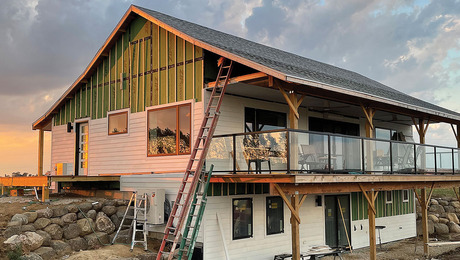January is National Radon Action Month

All of you who live in houses where radon is a possibility might want to have your house tested. http://www.epa.gov/radon/
In NC at least, radon tests are a part of every residential real estate transaction. EPA recommends homes be fixed if the radon level is 4 pCi/L (pico Curies per Liter) or more. In NC that falls upon the seller.
When we built Cloud Hidden, we did everything the county expert recommended to avoid radon in the house. Nonetheless, we tested at >15 pCi/L. It was a scary moment, be/c that’s one of the reasons a buyer can cancel a purchase. The SOP is that the seller has an abatement system installed and the house re-tested before closing. I learned a lot about all of this through talking with the abatement specialist who installed the system in the house.
First, he said 15 isn’t as bad as it might sound relative to the standard of 4. In our area, he typically found numbers over 25 and even found one that was 69 pCi/L.
The tricky part is where to locate the system. They need to be able to drill a 4″ hole in the slab, run a pipe from there up through the house and outside. By EPA guideline, the pipe is supposed to terminate some number of feet above the roof line, so that there’s no chance of the exhaust drifting back into the house. A fan is installed in-line to provide the suction–the idea being that it sucks the “radon air” out from the slab before it enters the house through cracks and gaps.
The effectiveness of the abatement system depends a lot on the slab preparation and installation. Proper thickness of gravel provides air pockets so that the suction can reach all areas of the slab. Footers that cut the slab into sections make this more difficult, because they block air flow. Expansion joints between slab and walls also make this more difficult, since they are hard to seal, and so the fan will end up sucking air from the house rather than under-slab.
The radiant floor heat system also complicated installation. To make closing, we were down to a schedule that had maybe 12 hours to spare–lab results were due the night before closing! If he perforated a PEX tube in the slab, the time to effect the fix might delay closing which would have had an unpleasant domino effect.
Fortunately I hadn’t packed the photo album away. In it were photos of the entire basement floor the morning of the concrete pour. With that, we identified the exact position of the PEX, as well as the details of the gravel and slab prep. The installer was able to penetrate the slab with no problems, run the pipe, exit it through the back wall (which took the longest of the steps because of awkward access), and tie the fan into the house wiring.
The installation took him 1 1/2 days, plus we met and spoke beforehand for at least 2 hours. As part of the installation he caulked the perimeter of the slab, plus every contraction crack on the basement floor. When he turned the system on, he got excellent suction, which was the goal. He left it run for two days to reach a steady state, placed the test canister in an appropriate spot for 24 hours (house should be free of people and activity), and sent it to the EPA-approved lab. He called me about 18 hours before closing with the results–2.5 pCi/L!
He made probably 6 trips from over 1 hour away. He spent probably 12 hours on site. He installed the pipe, the fan, caulked, added a suction gauge (manometer) showing suction of 3″ WC, and a bunch of stickers…$1675. The system is so quiet I could almost not hear it.
Interestingly, the house we bought near Winston-Salem also required abatement–it was just a hair over 4 pCi/L–required just one day for installation, has no manometer or labels, is much noisier (to the point of aggravation) and cost the sellers $1750.
FWIW, there’s not a whole lot that can be done to prevent radon when planning and building the house. We ran a pipe under the slab, as recommended, but the abatement expert chose to not use it. Avoiding expansion joint material was good. The amount of gravel was good. Pictures of the pre-slab preparation were a lifesaver!
Not everyone agrees on the danger represented by radon, but that’s a moot point when you’re signing a contract to sell a house and it’s a pre-printed requirement. To the extent that you’re concerned about it, consider having your house tested now–might cost from $25-$75.














